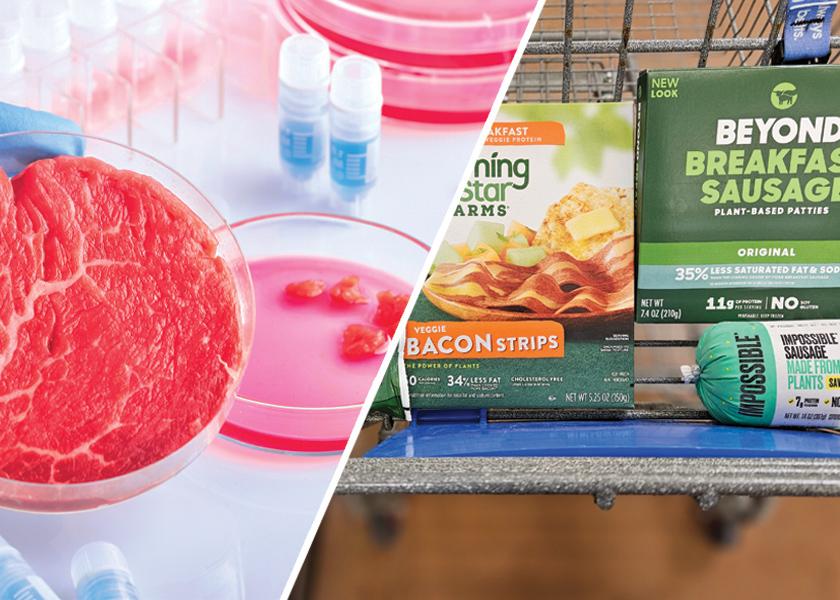Plant-Based Vs. Cell-Grown Meat Alternatives: Why You Need to Know the Difference

Those of us in the business of raising livestock have a hard time ignoring the questions about products being sold that imitate pork, beef or chicken. Even if we would like to deny their existence, they are still on store shelves and in restaurants, and inevitably someone will ask your opinion about them.
When we talk about meat-alternatives or meat analogs, there are two main products to consider:
1. Plant-based meats – Foods that are made to taste and feel like meat but are made from plants.
2. Lab-grown or cell-based meats – Meat grown from cells in media. The cells used to start this process are animal cells, but the product itself does not come from an animal.
Here’s a deeper dive into the differences between meat alternatives and a look at how much people are actually eating them today.
What exactly is plant-based pork?
Plant-based meats are probably something you’ve seen before, like Beyond Meats or Impossible Pork, and are made from plants. Each of those companies has several products that are made to replace meats in dishes like pork sausage or pork wontons. When developing the Impossible meats, food scientists looked for a way to imitate the savory flavor of meats. By inserting the DNA that codes for heme proteins in soy plants into yeast, they were able to grow the heme protein and mix it with soy proteins, coconut and sunflower oils, salt and a few other ingredients to make sausage or pork crumbles.
The Beyond Meat company does things a little bit differently, without the use of GMOs. Their protein sources are peas, mung beans, fava beans and brown rice, and coconut oil and cocoa butter are used to mimic the fats in meats. The meaty flavor is produced using beet juice extract, apple extract and other natural flavors. Obviously, both products are available in stores and restaurants.
How is cell-based pork differentiated?
Over 100 companies worldwide are working on products that produce ‘meat’ from cells grown in a plate or a lab. Growing the cells is not the hard part. Growing cells that resemble a meat product in a cost-effective way at a scale to feed thousands of people is the challenge.
These cells still must be fed a media of nutrients largely made from the same corn as pig feed. The cost of this media diet has decreased 300 times since 2019 and the conversion of the corn by the cells to edible product is about 4 lb. of feed to 1 lb. of pork, which the company compares to a Berkshire hog raised without antibiotics. Just like growing hogs, feed is the largest cost of these products.
Most of these cell-based meat companies are still in the research and development stage and several have gone bankrupt without producing a product. However, a few companies have built commercial-scale facilities. In Singapore, you can purchase a dish at a restaurant containing cell-based GOOD meats, and Upside Foods was granted USDA inspection in mid-June 2023. In the U.S., cell-based meats are regulated under dual inspection by FDA and USDA. Cells are grown on the FDA side of the plant and the meat products are produced on the USDA side. As of July 2023, we still haven’t seen cell-cultured meat available for sale in the U.S., but it is coming. It will likely be available in limited offerings at high-end restaurants before it makes its way to grocery store shelves.
Don’t lose sleep over it
When these products become regularly available and are seen in stores, what does that mean for conventionally raised pork? If we compare pork to plant-based meat alternatives, we can get an idea of the consumer interest and demand for meat alternatives.
Currently, plant-based meats make up about 0.3% of the retail market share compared to animal proteins at 99.7%, according to NielsenIQ. About 10% of American households have tried plant-based meats, but only about half of those have come back to purchase it a second time. About 70% of people who consume meat substitutes still eat meat at least once a week.
When consumers were asked to rank their top three protein sources, only 4% included meat substitutes (compare that to the 5% that include cricket powder). Plant-based meats are a tiny part of the market share, and I can’t imagine that the story will be very different for cell-based meats.
These products are undoubtedly going to become a new option for consumers when it comes to choosing proteins. However, the demand for conventionally raised pork is going to continue to rise with the increasing world population, and it’s doubtful that plant-based alternatives or cell-based pork will be a very big slice of the pie any time soon.
Read more:
Plant-Based Meat Alternatives: Is the Hype Over?
Is There Room at the Table for Meat and Alternative Proteins?







